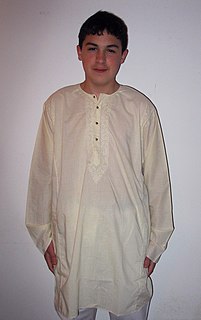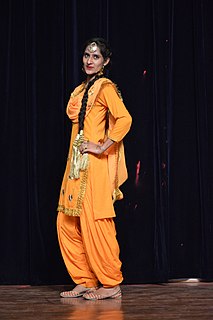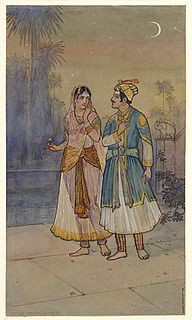Related Research Articles

Muslin is a cotton fabric of plain weave. It is made in a wide range of weights from delicate sheers to coarse sheeting. It gets its name from the city of Mosul, in Iraq, where it was first manufactured. In the 17th and 18th centuries Dacca in Bengal was regarded as producing the finest muslins.

A kurta is a loose collarless shirt worn in many regions of South Asia, and now also worn around the world. Tracing its roots to Central Asian nomadic tunics, or upper body garments, of the late-ancient- or early-medieval era, the kurta has evolved stylistically over the centuries, especially in South Asia, as a garment for everyday wear as well as for formal occasions.
Clothing in India is dependent upon the different ethnicities, geography, climate, and cultural traditions of the people of each region of India. Historically, male and female clothing has evolved from simple garments like kaupina, langota, achkan, lungi, sari, well as rituals and dance performances. In urban areas, western clothing is common and uniformly worn by people of all social levels. India also has a great diversity in terms of weaves, fibers, colours, and material of clothing. Sometimes, color codes are followed in clothing based on the religion and ritual concerned. The clothing in India also encompasses the wide variety of Indian embroidery, prints, handwork, embellishment, styles of wearing clothes. A wide mix of Indian traditional clothing and western styles can be seen in India.

Jamdani is a fine muslin textile produced for centuries in South Rupshi of Narayanganj district in Bangladesh on the bank of Shitalakhwa river. The historic production of jamdani was patronized by imperial warrants of the Mughal emperors. Under British colonialism, the Bengali jamdani and muslin industries rapidly declined due to colonial import policies favoring industrially manufactured textiles. In more recent years, the production of jamdani has witnessed a revival in Bangladesh. Jamdani is typically woven using a mixture of cotton and gold thread.

The study of the history of clothing and textiles traces the development, use, and availability of clothing and textiles over human history. Clothing and textiles reflect the materials and technologies available in different civilizations at different times. The variety and distribution of clothing and textiles within a society reveal social customs and culture.
SRF Limited is a multi-business chemicals conglomerate engaged in the manufacturing of industrial and specialty intermediates. The company’s business portfolio covers fluorochemicals, specialty chemicals, packaging films, technical textiles, coated and laminated fabrics. It has a workforce of close to 7,000 employees working across eleven manufacturing plants in India and one each in Thailand, South Africa and Hungary. The company exports to more than 75 countries.
The textile industry in India traditionally, after agriculture, is the only industry that has generated huge employment for both skilled and unskilled labour. The textile industry continues to be the second-largest employment generating sector in the India. It offers direct employment to over 35 million in the country. According to the Ministry of Textiles, the share of textiles in total exports during April–July 2010 was 11.04%. During 2009–2010, the Indian textile industry was pegged at US$55 billion, 64% of which services domestic demand. In 2010, there were 2,500 textile weaving factories and 4,135 textile finishing factories in all of India. According to AT Kearney’s ‘Retail Apparel Index’, India was ranked as the fourth most promising market for apparel retailers in 2009.
John Forbes Watson (1827–1892) was a Scottish physician and writer on India.

Piece goods were the textile materials sold in cut pieces as per the buyer's specification. The piece goods were either cut from a fabric roll or produced with a certain length, also called yard goods. Various textiles such as cotton, wool, silk, etc., were traded in terms of piece goods. The prices were determined as per the fabric quality.
Peshwaj was a ladies outfit similar to a gown or jama coat with front open, tied around the waist, having full sleeves, and the length was full neck to heels. Peshwaj was one of the magnificent costumes of the mughal court ladies. The material was used to be sheer and fine muslins with decorated borders of zari and lacework.

Izarband(naada, izārband, Izar band, Kamarband, Kamar Ki Patti and Patka, ازار بند) is a kind of girdle. Izarband is used to tie the upper part of various dresses such as salwar, pajamas, ghagra, petticoat, etc., in the Indian subcontinent. The said garments have the upper side turned inwards and stitched to make a narrow tubular passage, in which the izarband passes, there is one opening in the front side to collect and tie/ knot the ends. Izarband was one of the accessory (closures) items of textiles produced in the Punjab region. The Izarband is similar to a drawstring but narrower than a katzeb or a sash.
Puttoo was the coarse woolen cloth used in and before the 19th century in the Indian subcontinent. It was stuff made of camel's hair or yak.
Gurrah (garat) was a kind of calico produced in Northeast India during the 18th century. Gurrah was one of the cotton piece goods exported to England and France.

Mulboos khas was a special kind of mulmul cloth made for the King and used for Royal clothing in the Mughal Empire. The Mulboos khas was a kind of first-grade muslin exclusively manufactured in Royal Karkhanas notedly in places like Dacca, Sonargaon, Jangalbaree. Nur Jahan, the empress, was a great admirer of Dacca muslins. Mulboos khas was the finest and most expensive type of muslin, and it was used exclusively in Imperial use.

Jhuna was a fine sheer fabric, an open-weave structure similar to gauze. Jhuna was used primarily in the dresses of the dancers. It was another kind of fine muslin produced in Bengal with other peers such as Buddun khas, kumees, Rang.

Salembaree is an obsolete variant of cotton cloth that was a coase, stout and heavy fabric. It was made in the Indian subcontinent. The cloth was used for tents in India and Pakistan. Kathee was an alternative name for Salembaree. John Forbes Watson mentions these fabrics under the Canvas category in his work titled Textile Manufactures and Costumes of the people of India.
Peshgeer is one of the obsolete cotton piece goods produced in the Indian subcontinent. Peshgeer was a type of woven, printed material.
A mirzai was a garment similar to a jacket with "long and loose sleeves and open cuffs". It was worn under the jacket by males in the Indian subcontinent in the 19th century. The mirzai was sometimes made with cotton padding to protect the wearer from cold.
Punjum was a type of Indian cotton cloth. It was produced in the Northern Circars, on the Coromandel Coastal region in South East India. Punjum was a kind of cotton longcloth that was produced in a variety of thread counts.
Angia was a form of bodice of Indian origin. It was a type of garment used to cover the bosom that was tied at the back with strings. It was also termed "Anggiya", "Anggiya" a garment that covers the entire upper body from the bust to the waist. Very short sleeves and waist length characterize Anggiya. It was made of fine cotton material like muslin. Anggiya was an item of clothing dating back to the 1800s. Women in India wore it beneath dresses such as Peshwaj.
References
- ↑ Panjab University Research Bulletin: Arts. The University. 1983. p. 43.
- ↑ Kumar, Ritu (2006). Costumes and Textiles of Royal India. Antique Collectors' Club. p. 330. ISBN 978-1-85149-509-2.
- ↑ Watson, John Forbes (1867). The Textile Manufactures and the Costumes of the People of India. Allen. p. 56.